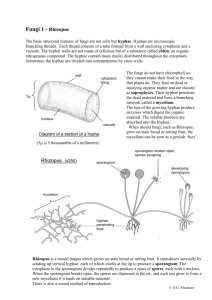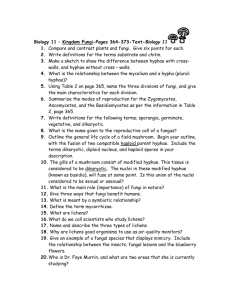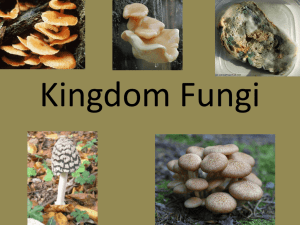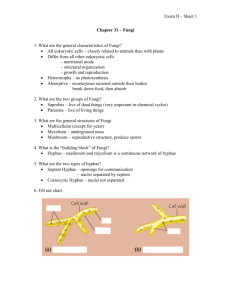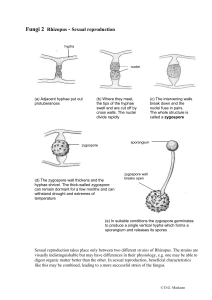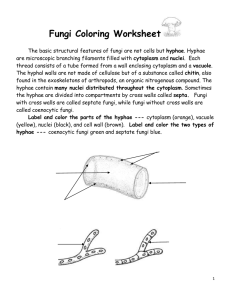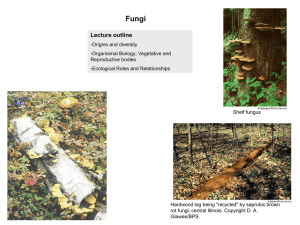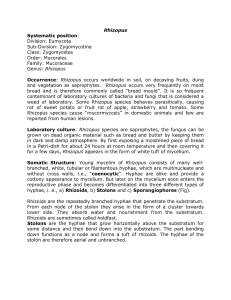3.1.4 Fungi
advertisement
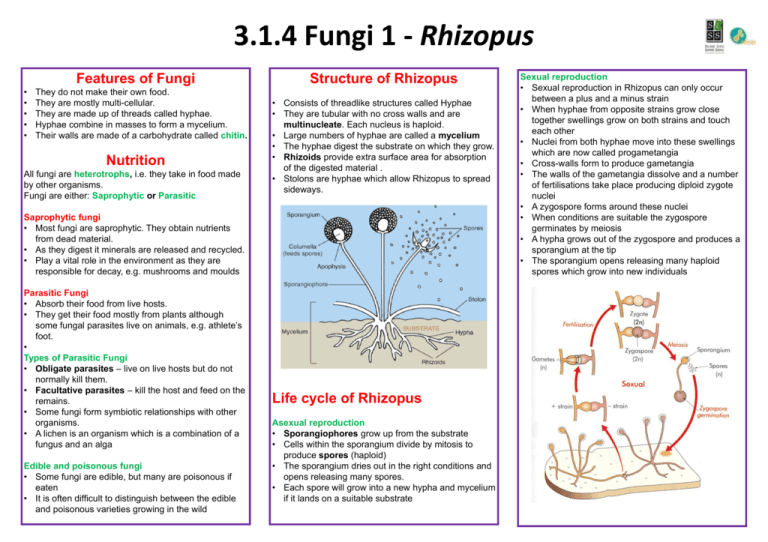
3.1.4 Fungi 1 - Rhizopus Features of Fungi • • • • • They do not make their own food. They are mostly multi-cellular. They are made up of threads called hyphae. Hyphae combine in masses to form a mycelium. Their walls are made of a carbohydrate called chitin. Nutrition All fungi are heterotrophs, i.e. they take in food made by other organisms. Fungi are either: Saprophytic or Parasitic Structure of Rhizopus • Consists of threadlike structures called Hyphae • They are tubular with no cross walls and are multinucleate. Each nucleus is haploid. • Large numbers of hyphae are called a mycelium • The hyphae digest the substrate on which they grow. • Rhizoids provide extra surface area for absorption of the digested material . • Stolons are hyphae which allow Rhizopus to spread sideways. Saprophytic fungi • Most fungi are saprophytic. They obtain nutrients from dead material. • As they digest it minerals are released and recycled. • Play a vital role in the environment as they are responsible for decay, e.g. mushrooms and moulds Parasitic Fungi • Absorb their food from live hosts. • They get their food mostly from plants although some fungal parasites live on animals, e.g. athlete’s foot. • Types of Parasitic Fungi • Obligate parasites – live on live hosts but do not normally kill them. • Facultative parasites – kill the host and feed on the remains. • Some fungi form symbiotic relationships with other organisms. • A lichen is an organism which is a combination of a fungus and an alga Edible and poisonous fungi • Some fungi are edible, but many are poisonous if eaten • It is often difficult to distinguish between the edible and poisonous varieties growing in the wild Life cycle of Rhizopus Asexual reproduction • Sporangiophores grow up from the substrate • Cells within the sporangium divide by mitosis to produce spores (haploid) • The sporangium dries out in the right conditions and opens releasing many spores. • Each spore will grow into a new hypha and mycelium if it lands on a suitable substrate Sexual reproduction • Sexual reproduction in Rhizopus can only occur between a plus and a minus strain • When hyphae from opposite strains grow close together swellings grow on both strains and touch each other • Nuclei from both hyphae move into these swellings which are now called progametangia • Cross-walls form to produce gametangia • The walls of the gametangia dissolve and a number of fertilisations take place producing diploid zygote nuclei • A zygospore forms around these nuclei • When conditions are suitable the zygospore germinates by meiosis • A hypha grows out of the zygospore and produces a sporangium at the tip • The sporangium opens releasing many haploid spores which grow into new individuals
